
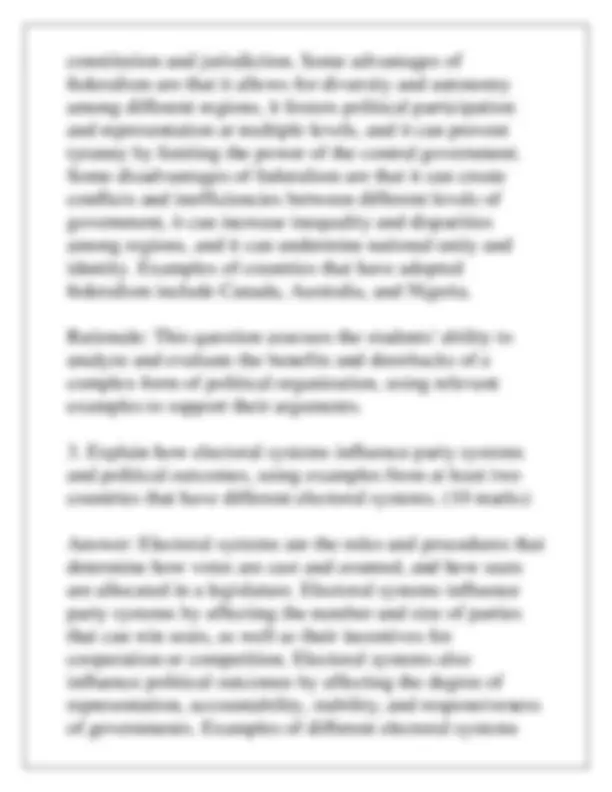
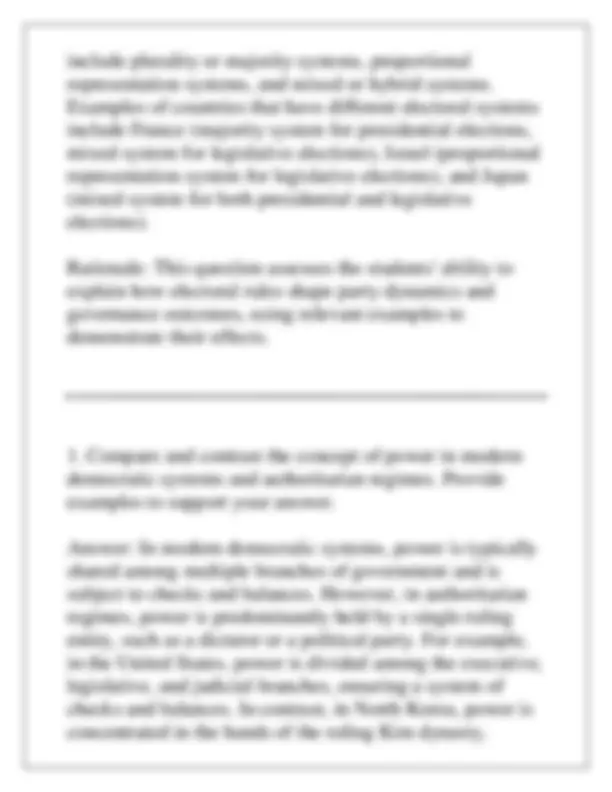
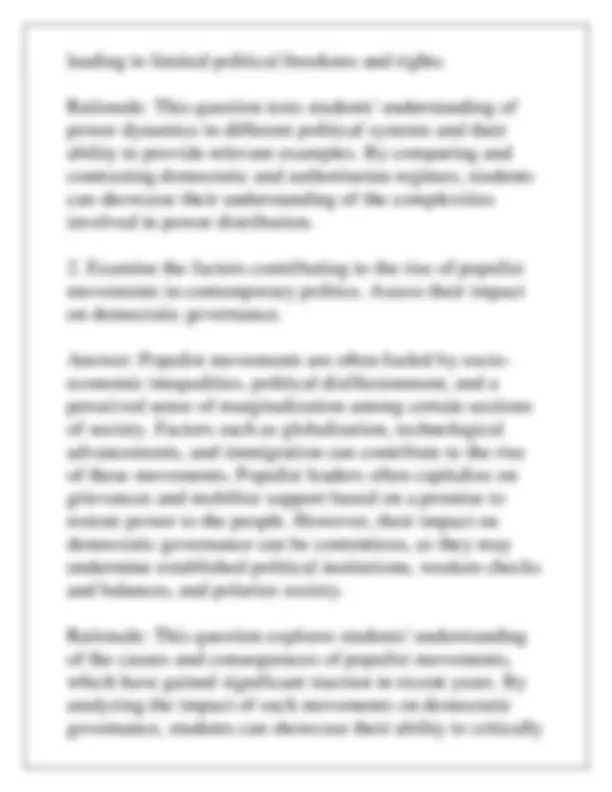
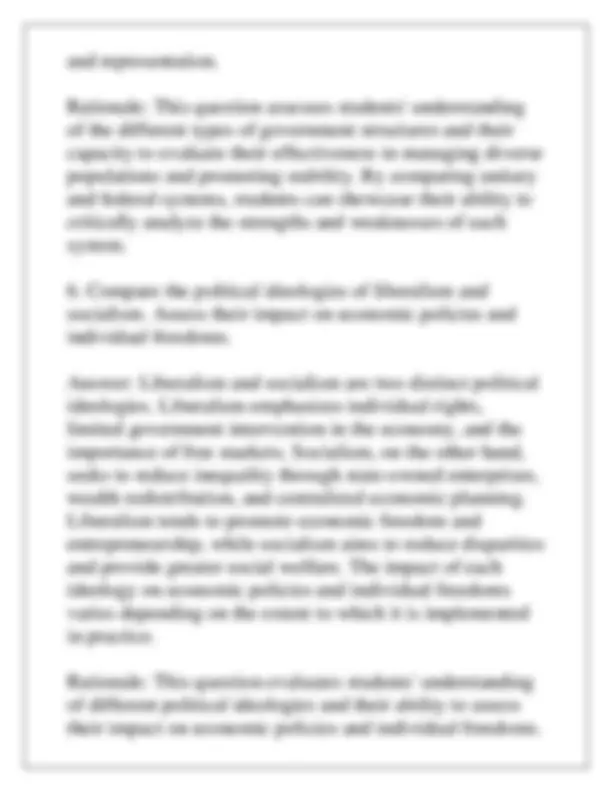
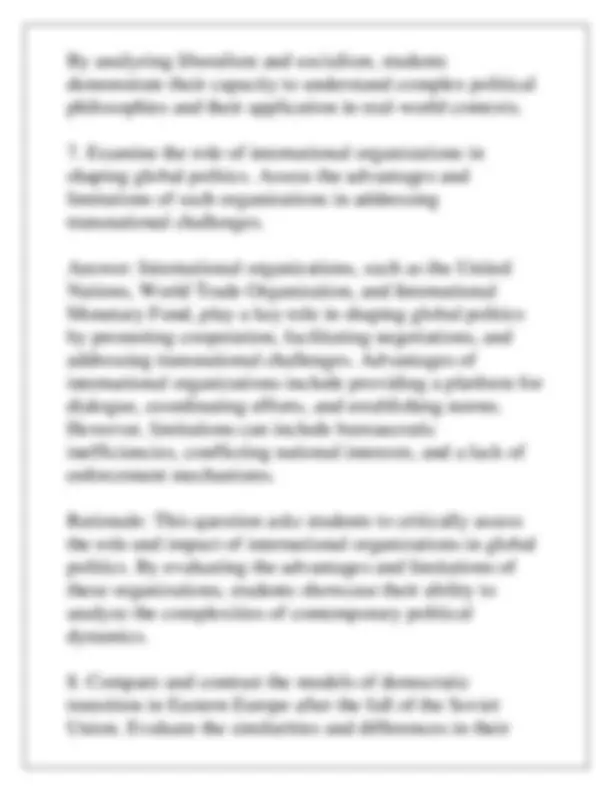
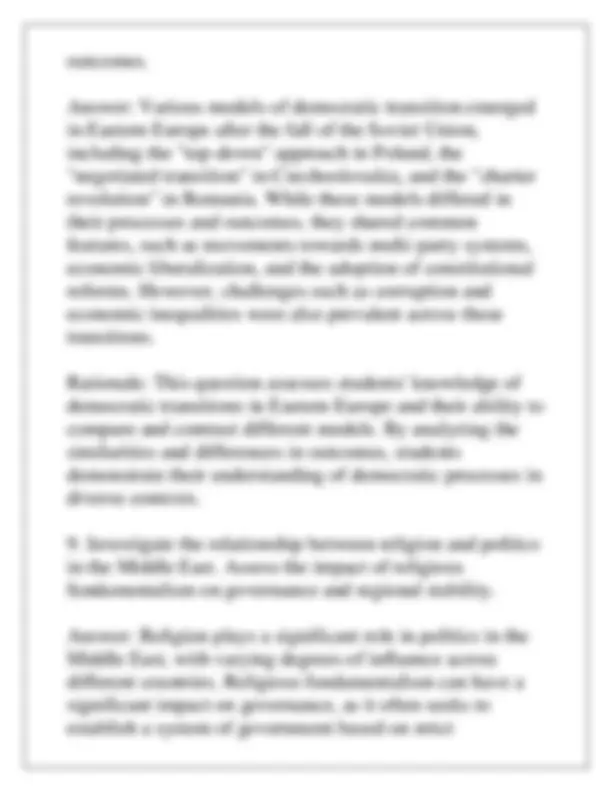
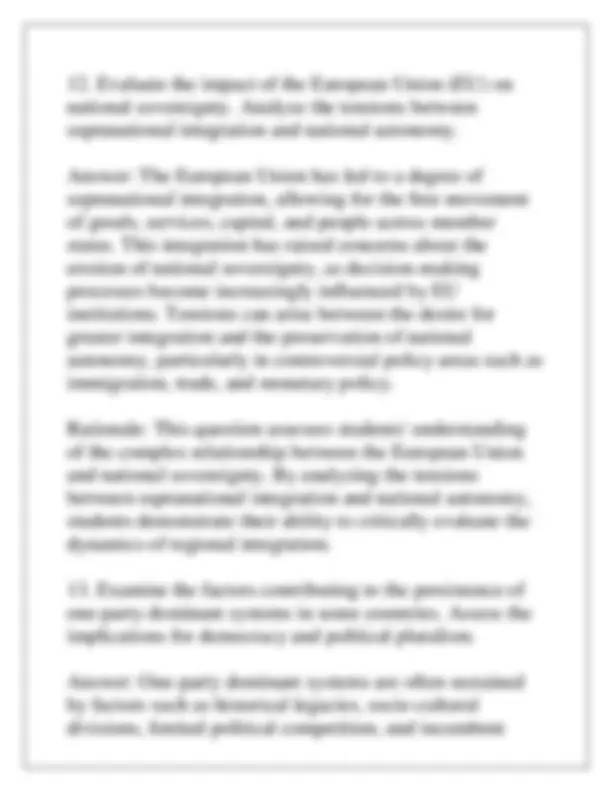
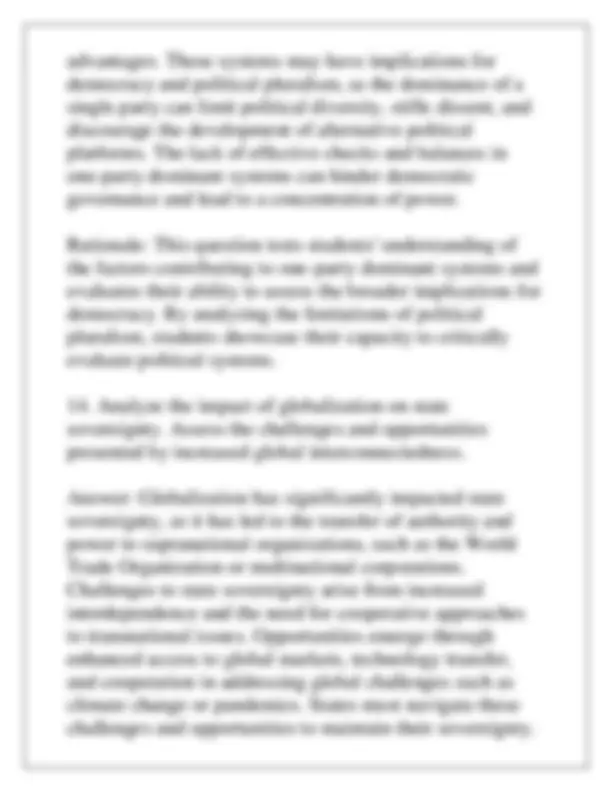
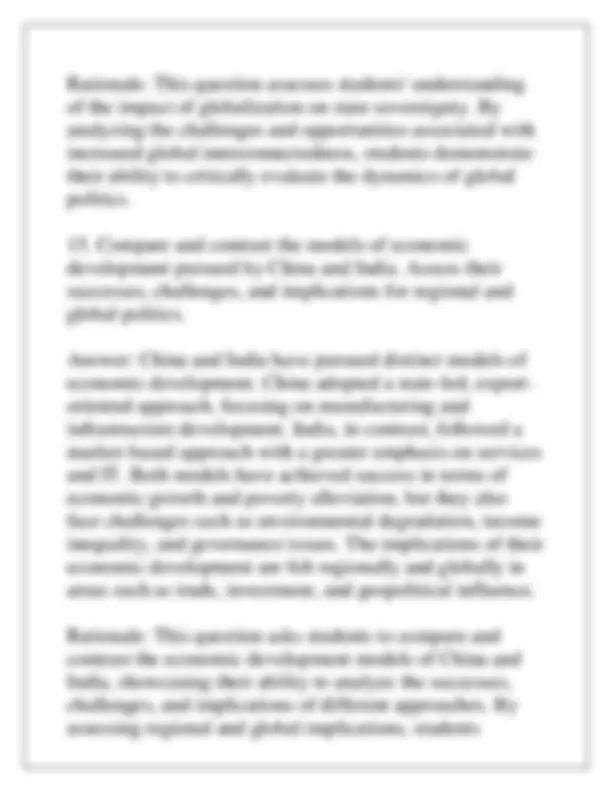
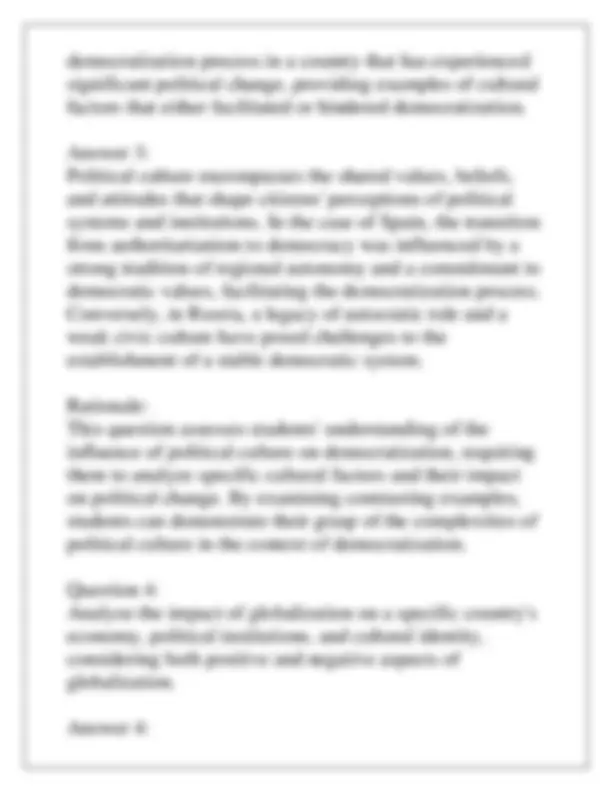
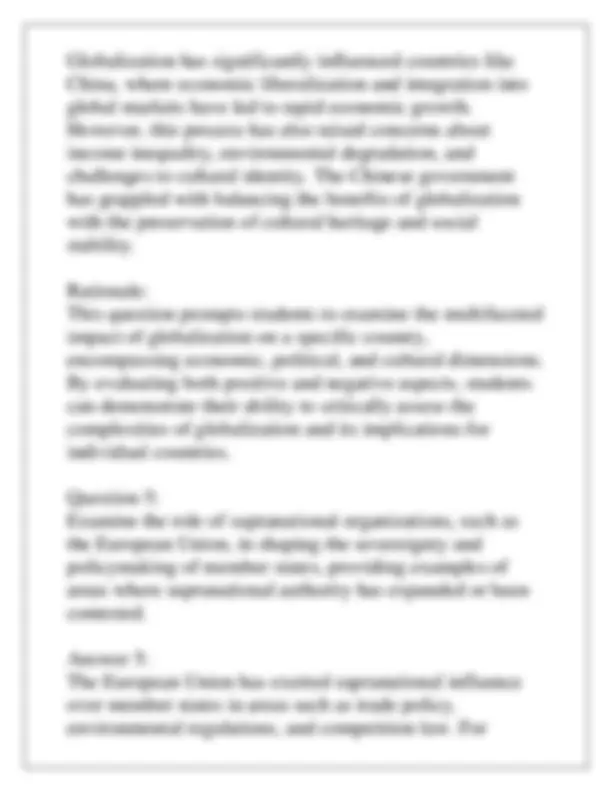
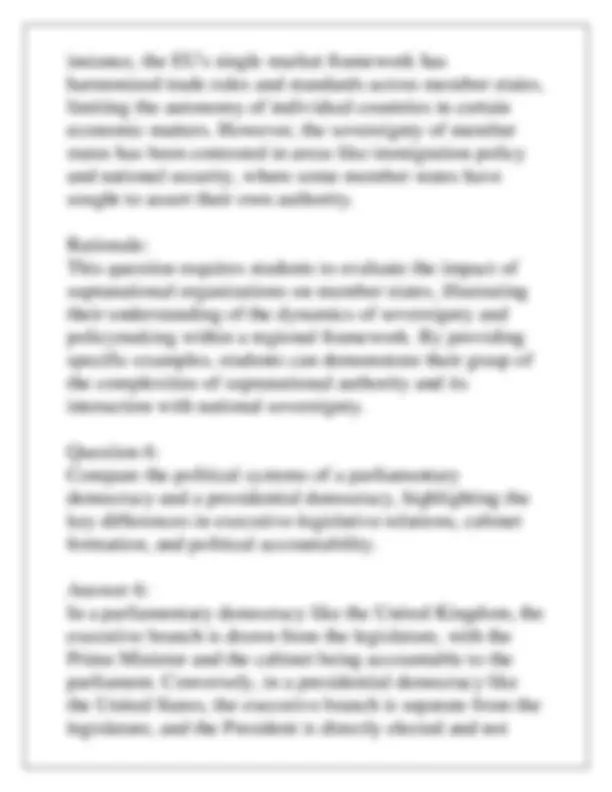
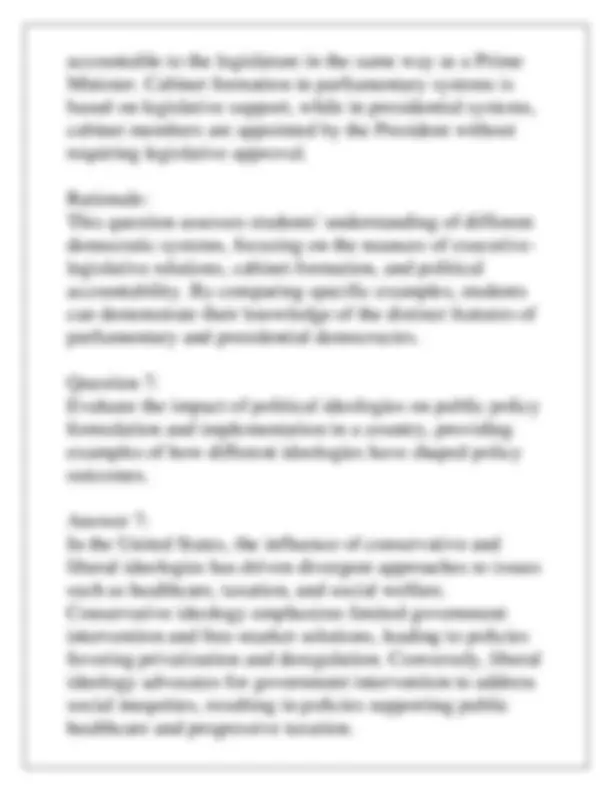
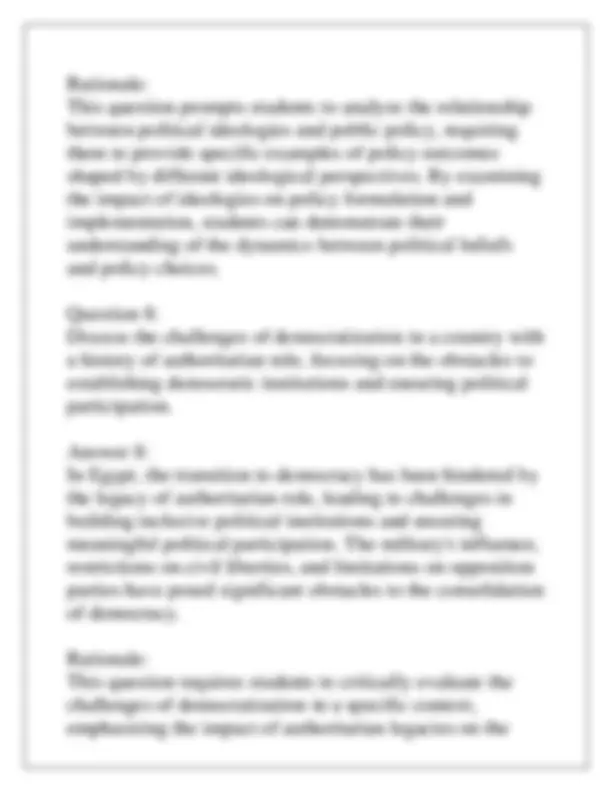
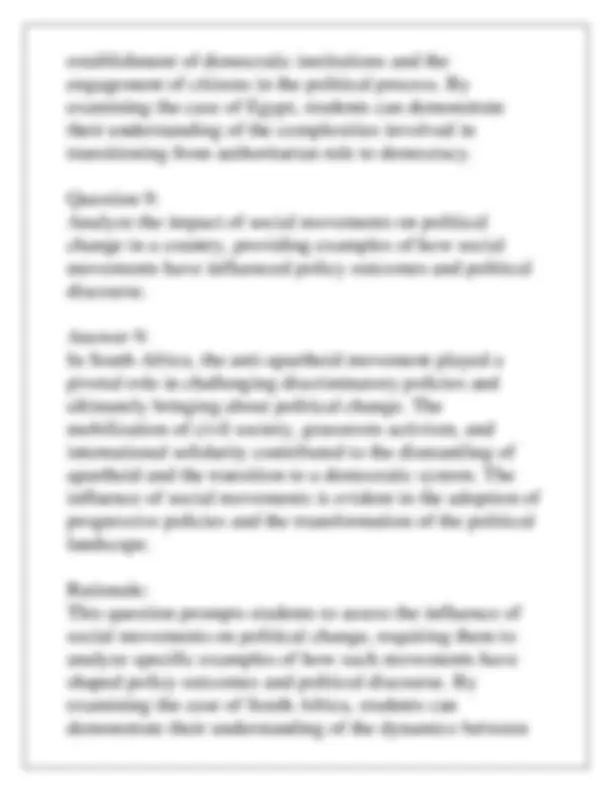
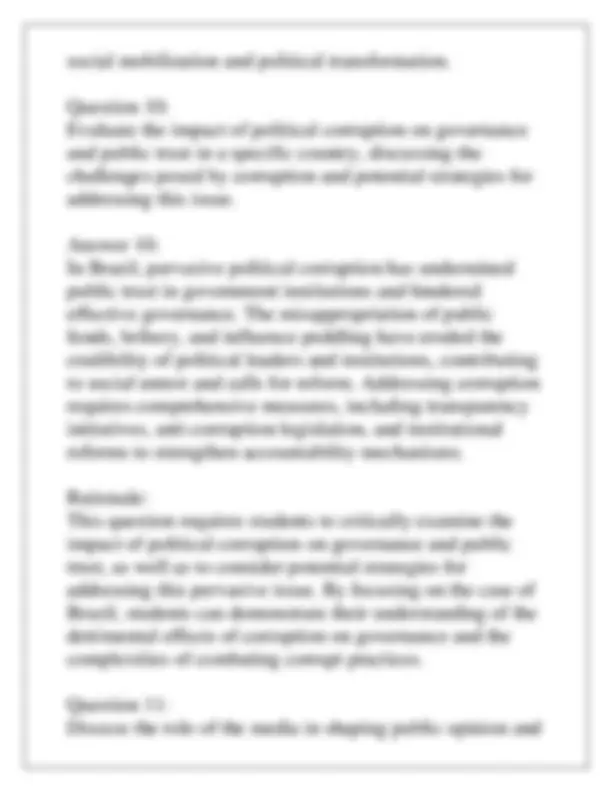
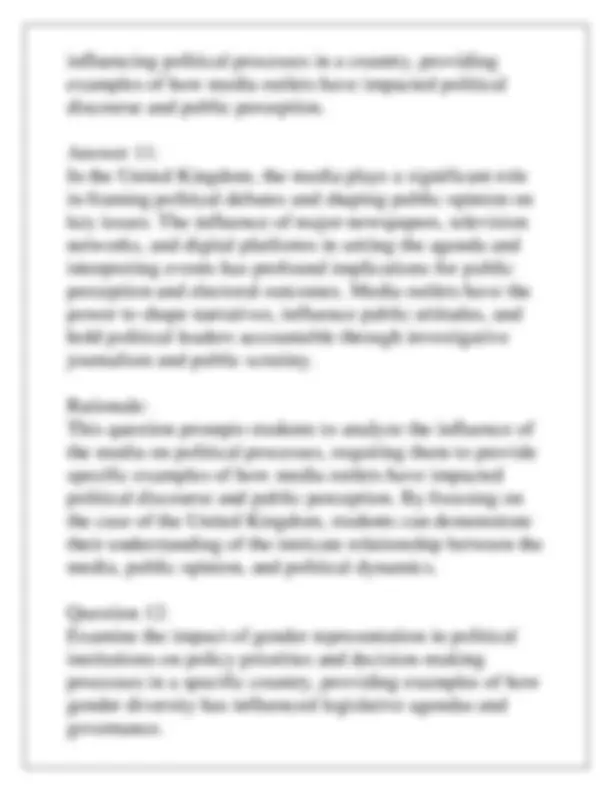
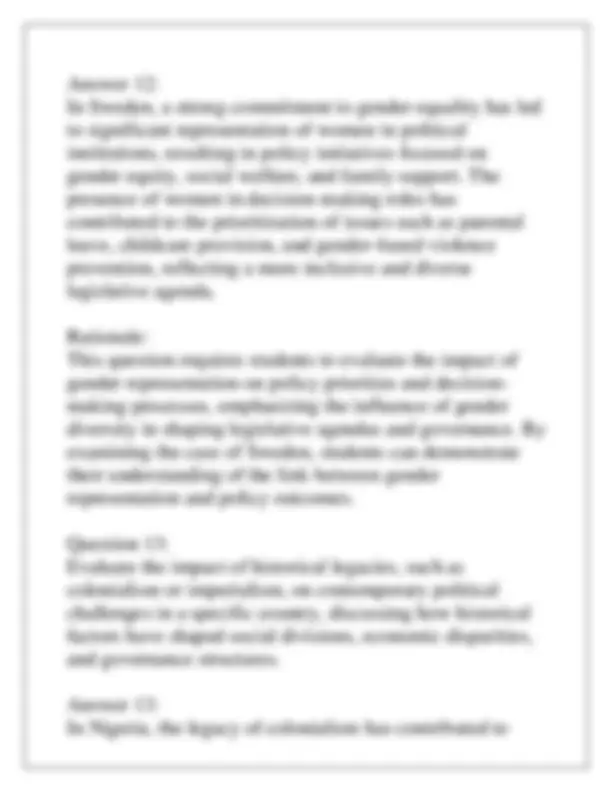
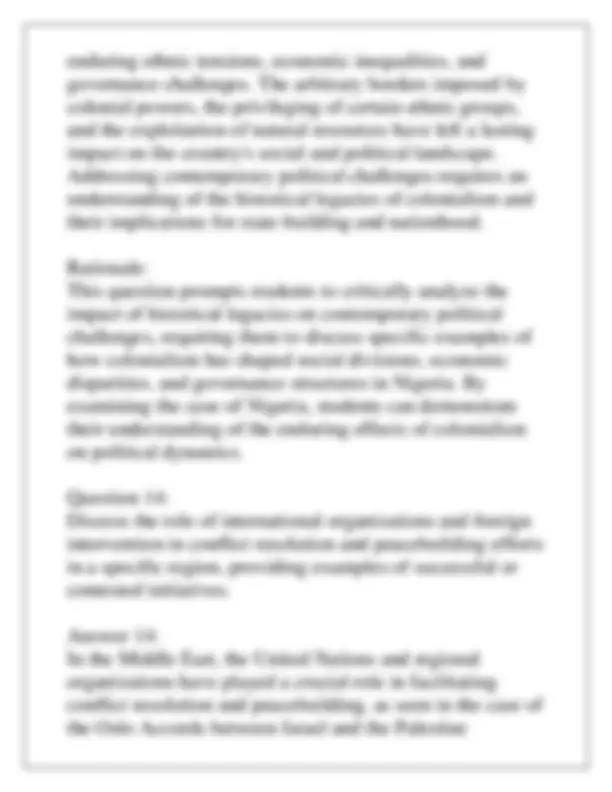
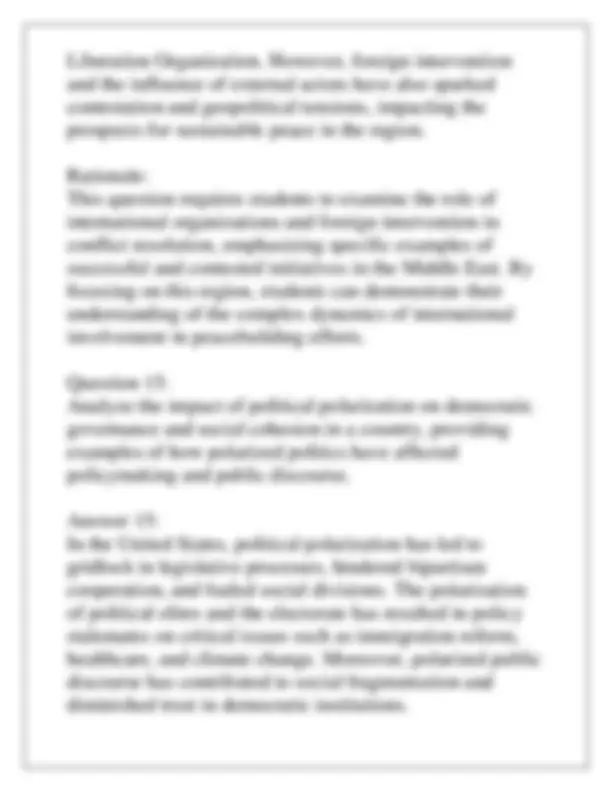
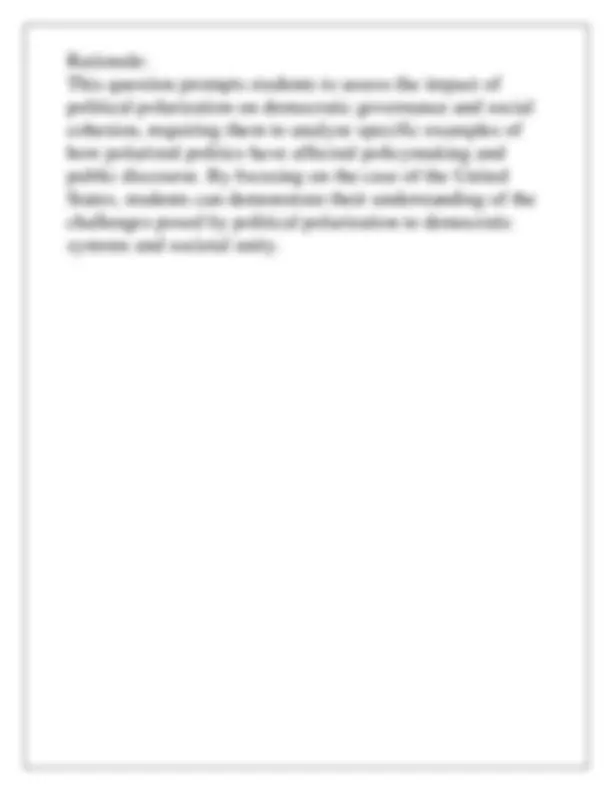


Study with the several resources on Docsity

Earn points by helping other students or get them with a premium plan


Prepare for your exams
Study with the several resources on Docsity

Earn points to download
Earn points by helping other students or get them with a premium plan
Community
Ask the community for help and clear up your study doubts
Discover the best universities in your country according to Docsity users
Free resources
Download our free guides on studying techniques, anxiety management strategies, and thesis advice from Docsity tutors
A practice exam with questions and answers related to comparative politics. The questions cover topics such as different types of democratic systems, federalism, electoral systems, democratic consolidation, unitary and federal systems of government, democratic transitions in Eastern Europe, religion and politics in the Middle East, political polarization in the United States, and the impact of globalization on state sovereignty. The answers provide examples from different countries and assess the strengths, weaknesses, and implications of each system or phenomenon. The document aims to test students' knowledge and critical thinking skills in comparative politics.
Typology: Exams
1 / 29

This page cannot be seen from the preview
Don't miss anything!






















include plurality or majority systems, proportional representation systems, and mixed or hybrid systems. Examples of countries that have different electoral systems include France (majority system for presidential elections, mixed system for legislative elections), Israel (proportional representation system for legislative elections), and Japan (mixed system for both presidential and legislative elections). Rationale: This question assesses the students' ability to explain how electoral rules shape party dynamics and governance outcomes, using relevant examples to demonstrate their effects.
leading to limited political freedoms and rights. Rationale: This question tests students' understanding of power dynamics in different political systems and their ability to provide relevant examples. By comparing and contrasting democratic and authoritarian regimes, students can showcase their understanding of the complexities involved in power distribution.
which democratic institutions become deeply ingrained within a society, ensuring stable governance. Factors contributing to democratic consolidation include the establishment of the rule of law, respect for human rights, the presence of strong civil society organizations, and peaceful transitions of power. Economic development can also play a significant role, as prosperous economies tend to have a larger and more prosperous middle class, which can support and sustain democratic institutions. Rationale: This question allows students to demonstrate their understanding of democratic consolidation and examine the various factors influencing its success. By analyzing the relationship between economic development and democracy, students showcase their ability to evaluate the broader socio-economic context in political processes.
and representation. Rationale: This question assesses students' understanding of the different types of government structures and their capacity to evaluate their effectiveness in managing diverse populations and promoting stability. By comparing unitary and federal systems, students can showcase their ability to critically analyze the strengths and weaknesses of each system.
outcomes. Answer: Various models of democratic transition emerged in Eastern Europe after the fall of the Soviet Union, including the "top-down" approach in Poland, the "negotiated transition" in Czechoslovakia, and the "charter revolution" in Romania. While these models differed in their processes and outcomes, they shared common features, such as movements towards multi-party systems, economic liberalization, and the adoption of constitutional reforms. However, challenges such as corruption and economic inequalities were also prevalent across these transitions. Rationale: This question assesses students' knowledge of democratic transitions in Eastern Europe and their ability to compare and contrast different models. By analyzing the similarities and differences in outcomes, students demonstrate their understanding of democratic processes in diverse contexts.
interpretations of religious doctrines. This can lead to a lack of pluralism, restrictions on individual freedoms, and challenges to democratic governance. Religious fundamentalism also has implications for regional stability, as it can fuel conflicts and exacerbate sectarian divisions. Rationale: This question allows students to explore the complexities of the relationship between religion and politics in the Middle East. By analyzing the impact of religious fundamentalism on governance and stability, students showcase their ability to critically evaluate the socio-political dynamics of a specific region.
advantages. These systems may have implications for democracy and political pluralism, as the dominance of a single party can limit political diversity, stifle dissent, and discourage the development of alternative political platforms. The lack of effective checks and balances in one-party dominant systems can hinder democratic governance and lead to a concentration of power. Rationale: This question tests students' understanding of the factors contributing to one-party dominant systems and evaluates their ability to assess the broader implications for democracy. By analyzing the limitations of political pluralism, students showcase their capacity to critically evaluate political systems.
demonstrate their understanding of the broader impact of economic policies. Question 1: Explain the concept of electoral systems and analyze the impact of proportional representation versus majoritarian systems on political representation and party dynamics in at least two different countries. Answer 1: Electoral systems refer to the method used to translate votes into seats in a representative assembly. In a proportional representation system, seats are allocated in proportion to the votes received by each party, leading to a multi-party system and increased representation of diverse political views. This system is exemplified by countries like Germany and the Netherlands. On the other hand, majoritarian systems, such as the first-past-the-post system in the United Kingdom and the United States, tend to produce a two-party system and can lead to disproportionate representation, particularly for smaller parties. Rationale: This question assesses students' understanding of electoral systems and their ability to compare the impact of different systems on political representation and party dynamics. It requires them to analyze real-world examples,
demonstrating their knowledge of specific countries and their electoral processes. Question 2: Evaluate the role of federalism in managing ethnic, linguistic, or regional diversity in a specific country, and compare it to the approach taken by another country facing similar challenges. Answer 2: Federalism, as a system of government, seeks to balance power between a central authority and constituent political units such as states or provinces. This allows for the accommodation of diverse ethnic, linguistic, or regional identities within a country. For instance, India and Canada both adopt federal systems to address diversity, with India managing linguistic diversity through the establishment of states based on language, while Canada addresses regional diversity by granting significant autonomy to provinces like Quebec. Rationale: This question requires students to critically analyze the role of federalism in addressing diversity and to compare the approaches of different countries. By examining specific case studies, students can demonstrate their understanding of federal systems and their application in diverse contexts. Question 3: Discuss the impact of political culture on the
Globalization has significantly influenced countries like China, where economic liberalization and integration into global markets have led to rapid economic growth. However, this process has also raised concerns about income inequality, environmental degradation, and challenges to cultural identity. The Chinese government has grappled with balancing the benefits of globalization with the preservation of cultural heritage and social stability. Rationale: This question prompts students to examine the multifaceted impact of globalization on a specific country, encompassing economic, political, and cultural dimensions. By evaluating both positive and negative aspects, students can demonstrate their ability to critically assess the complexities of globalization and its implications for individual countries. Question 5: Examine the role of supranational organizations, such as the European Union, in shaping the sovereignty and policymaking of member states, providing examples of areas where supranational authority has expanded or been contested. Answer 5: The European Union has exerted supranational influence over member states in areas such as trade policy, environmental regulations, and competition law. For
instance, the EU's single market framework has harmonized trade rules and standards across member states, limiting the autonomy of individual countries in certain economic matters. However, the sovereignty of member states has been contested in areas like immigration policy and national security, where some member states have sought to assert their own authority. Rationale: This question requires students to evaluate the impact of supranational organizations on member states, illustrating their understanding of the dynamics of sovereignty and policymaking within a regional framework. By providing specific examples, students can demonstrate their grasp of the complexities of supranational authority and its interaction with national sovereignty. Question 6: Compare the political systems of a parliamentary democracy and a presidential democracy, highlighting the key differences in executive-legislative relations, cabinet formation, and political accountability. Answer 6: In a parliamentary democracy like the United Kingdom, the executive branch is drawn from the legislature, with the Prime Minister and the cabinet being accountable to the parliament. Conversely, in a presidential democracy like the United States, the executive branch is separate from the legislature, and the President is directly elected and not